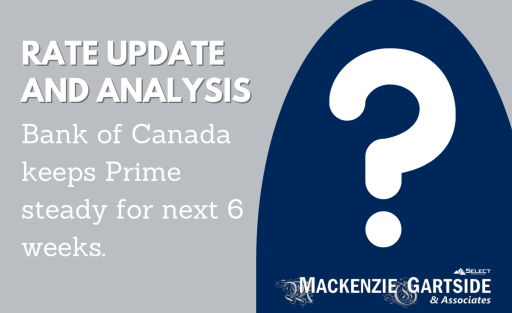Today the Bank of Canada (BoC) announced that it would keep the overnight Prime lending rate unchanged for the next 6 weeks. The BoC’s overnight lending rate is currently at 4.5%.
You can find our best mortgage rates here.
Variable Rate Analysis
It was largely expected for the BoC to leave Prime unchanged at this meeting, after the BoC indicated at the last meeting (Jan 25th) that it would be taking a “pause” in rate changes to assess the impact that the aggressive rate increases of last year are having as they continue to impact business and consumer activity.
Most economists think it takes between 6-12 months for a BoC rate change to work its way into the economy in a measurable way (i.e. businesses have to change their future forecasts based on the new interest rate borrowing costs, then decide how to adapt their upcoming activities, then implement those changes, and then Statistics Canada or another reporting agency has to generate a report that shows the results of the new business activity).
The most recent economic data available shows the Canadian economy didn’t grow at all over the last quarter of 2022. In other words, our economy is verging on entering a recession (which most economists define as 2 consecutive quarters of negative growth). Many economists were predicting a minor recession at the end of 2023, but this most recent data suggests we may be heading into the start of a recession already.
The most recent data also shows a continued decline in Canada’s inflation rate. Currently at 5.9%, it is down from the all time high of 8.1% in June 2022. This is partially a result of global factors caused by the pandemic and Russia’s invasion of Ukraine easing:
- Commodity prices and shipping costs have both dropped substantially since last year
- Supply chains are recovering
Both of these factors mean that businesses are operating more smoothly and are returning to more streamlined operations, allowing them to increase production efficiently to meet demand levels.
As well, the higher borrowing costs brought on by the BoC rate increases last year are slowly changing consumer and business behaviours, causing people to cut back on spending for non-essential goods and services and businesses to reduce inventory and stocking levels.
With higher and cheaper supply combining with less demand for goods and services, we hope to see prices stabilize across many areas.
At the next BoC meeting on April 12th, the BoC will have a chance to evaluate March inflation and jobs data (which will be released in early April) and hopefully we will continue to see the above trends play out to give the BoC more confidence in keeping variable rates flat.
The biggest risk right now to the battle against inflation seems to be the U.S. economy’s continued strength, despite the Federal Reserve’s rate increases over the last 9 months. The Federal Reserve began its monetary tightening later than the Bank of Canada and the most recent data shows that it will quite possibly have to raise rates in the U.S. higher and keep them there longer than many were expecting.
Higher interest rates in the U.S. (compared to Canada) cause the U.S. dollar to appreciate in value relative to the Canadian dollar (i.e. the Canadian dollar becomes weaker), which means any businesses that import goods or services from the U.S. have to pay more Canadian dollars to get the same quantity or service. The higher costs of these imports are then passed on to the consumer as higher prices, resulting in inflation, and because the U.S. is our largest trading partner and we import a lot of goods and services from there, even a relatively small change in currency values can cause price inflation across a wide cross section of our economy.
Fixed Rate Analysis
Fixed rates are not directly affected by the Bank of Canada rate decisions. Instead, they are affected by bond market activity (which reflect the interest rates that institutional investors require in order to lend money for a set period of time given different levels of risk). Bond rates generally go up when the economy is performing well (when investors have more opportunities to make money with other investments, borrowers have to pay more money to convince investors to fund loans), and bond rates go down when the economic outlook is poor (if investors don’t expect to be able to make good returns investing in other ways, they will put more money towards funding safe loans to borrowers and will accept less returns to do so).
Over the last few months, bond rates have been increasing and decreasing substantially with every new economic report that comes out, as investors are very uncertain about what the future holds. This has led to fixed mortgage rates going up and down in cycles every month or two. Our long term outlook continues to be that we believe fixed rates are going to slowly decrease over the next 2 years as the Canadian economy enters a mild recession. However, due to the volatility from month to month it is still important to be strategic and try to secure fixed rates during a dip in the cycle. For any property buyers looking to purchase this spring/summer, we strongly recommend working with your broker to make sure you have a fixed rate hold in place so you’re protected against any fluctuations that might occur during your property search.
Have questions?
We are always happy to discuss your financing needs!
Please book an appointment today with one of our broker team to discuss your plans and we’ll make sure you have all the information you need to make the best financial decision and get the best mortgage to reach your goals.




